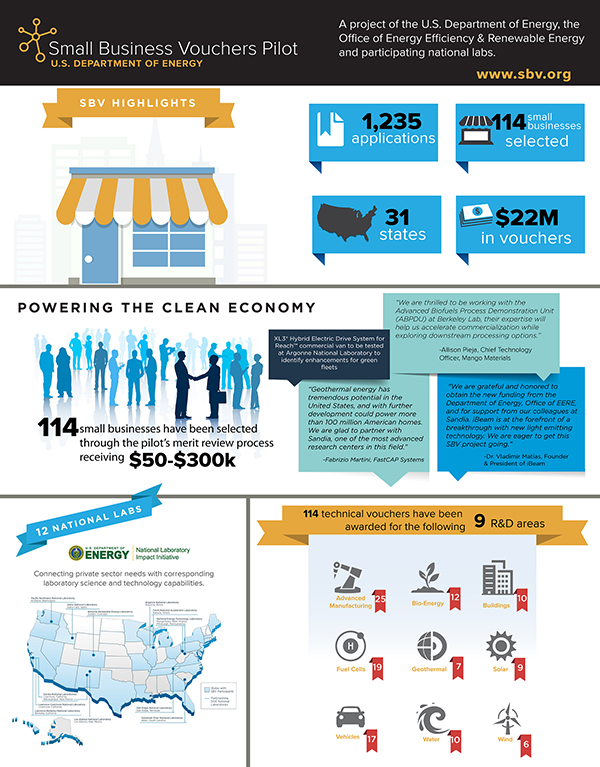More small, clean-energy businesses will tap into Sandia technical expertise
DOE has chosen five more small, clean-energy businesses to work with Sandia to speed the commercialization of next-generation technologies and gain a global competitive advantage for the US.
“Sandia is excited to bring these small businesses together with our scientists and engineers to tackle challenges and bring new products to the clean-energy marketplace,” says Mary Monson, senior manager of Industry Partnerships Dept. 1180. “These partnerships support our energy mission and help the companies and the economy. We’re delighted to be a part of this kind of technology transfer.”

The Small Business Vouchers pilot, or SBV, was launched in September 2015 letting companies apply for technical help from DOE labs. In March 2016, 33 companies were selected to receive $6.7 million in funding. Seven of them are working with Sandia through vouchers totaling $1.62 million. In August 2016, an additional 43 companies were chosen to receive $8 million in vouchers, five of them with Sandia totaling $983,000.
The announcement of third-round awards was made April 18 at Earth Day Texas in Dallas. The DOE Office of Energy Efficiency and Renewable Energy, or EERE, says eight national labs will receive $7.3 million in vouchers to work with 38 small businesses. The companies selected to work with Sandia are M3 Wave LLC of Salem, Oregon; California Wave Power Technologies LLC of Berkeley; Sentient Science Corp. of Buffalo, New York; Ceramic Tubular Products of Lynchburg, Virginia; and Vacuum Process Engineering Inc. of Sacramento, California. The vouchers total $1.14 million and range from $160,000 to $354,000 each.
“Sandia is working through the SBV pilot with small businesses nationwide, creating jobs and economic vitality,” says Jackie Kerby Moore, manager of Technology and Economic Development Dept. 1183. “The potential for widespread national impact from these partnerships is profound and exhilarating.”
The potential for widespread national impact from these partnerships is profound and exhilarating.
The pilot, part of EERE’s Technology-to-Market program, aims to help small businesses by letting them tap into world-class expertise and tools at the labs to solve critical technology challenges. The pilot will fund projects in the areas of solar, geothermal, wind, water power, fuel cells, advanced manufacturing, bioenergy, buildings, and vehicles. The types of projects include prototyping, materials characterization, high-performance computing, modeling and simulation, scaling to generate customer samples, performance validation, and regulatory compliance.
The eight DOE national laboratories participating in the new round of collaborations are home to some of the most advanced, cutting edge research sites in the world, including Sandia’s Scaled Wind Farm Technology, known as SWiFT.
Lead lab in solar, wind, geothermal
In 2015, DOE chose Sandia as one of five leads in the $20 million pilot to head the sectors of solar energy, wind energy, and geothermal technologies. Other leads are the National Renewable Energy Laboratory, Lawrence Berkeley National Laboratory, Oak Ridge National Laboratory, and Pacific Northwest National Laboratory.
The latest companies selected to collaborate with Sandia are working on a wide variety of clean-energy efforts:
- M3 Wave will work with Sandia and the National Renewable Energy Laboratory to adapt its deep-water modeling tool, NEXUS, to track differential wave energy by re-creating conditions common on the ocean floor. The goal is to develop a more complex modeling system to predict and increase areas of efficiency up to 25 percent.
- California Wave Power wants to identify, design, and assess decision-making systems to advance wave energy converter technology and do scaled prototype testing of the systems. The project could accelerate adoption and increase the capacity of marine hydrokinetics energy in the US by 70 percent or more.
- Sentient Science is developing a technology to predict and extend wind turbine blade life and significantly cut the cost of wind energy.
- Ceramic Tubular’s high efficiency, low emissivity receiver tubes for concentrating solar power plants could let them operate at higher temperatures and efficiencies and help achieve the DOE SunShot goal of six cents per kilowatt hour cost of electricity by 2020.
- Vacuum Process Engineering is working on a process to greatly increase the capacity and reduce the cost of microchannel heat exchangers. The project will use Sandia’s 3-D printing to test and evaluate the process.
“Sandia has been a pioneer in clean-energy technologies,” says Juan Torres, chief of operations for Sandia’s Energy and Climate programs. “We have decades of expertise in solar, wind, water power, and bioenergy, and can help these companies be successful.”